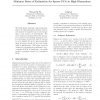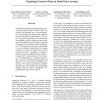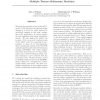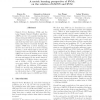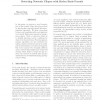129
Voted
JMLR
2012
13 years 3 months ago
2012
Motivated by the observation that coarse and fine resolutions of an image reveal different structures in the underlying visual phenomenon, we present a model based on the Deep B...
117
click to vote
JMLR
2012
13 years 3 months ago
2012
We study sparse principal components analysis in the high-dimensional setting, where p (the number of variables) can be much larger than n (the number of observations). We prove o...
139
Voted
JMLR
2012
13 years 3 months ago
2012
We study the prevalent problem when a test distribution differs from the training distribution. We consider a setting where our training set consists of a small number of sample d...
120
Voted
JMLR
2012
13 years 3 months ago
2012
We study the problem of learning a group of principal tasks using a group of auxiliary tasks, unrelated to the principal ones. In many applications, joint learning of unrelated ta...
146
Voted
JMLR
2012
13 years 3 months ago
2012
Contextual bandit learning is a reinforcement learning problem where the learner repeatedly receives a set of features (context), takes an action and receives a reward based on th...
148
Voted
JMLR
2012
13 years 3 months ago
2012
We assess the generative power of the mPoTmodel of [10] with tiled-convolutional weight sharing as a model for visual textures by specifically training on this task, evaluating m...
130
click to vote
JMLR
2012
13 years 3 months ago
2012
Support Vector Machines, SVMs, and the Large Margin Nearest Neighbor algorithm, LMNN, are two very popular learning algorithms with quite different learning biases. In this paper...
121
Voted
JMLR
2012
13 years 3 months ago
2012
Often when modeling structured domains, it is desirable to leverage information that is not naturally expressed as simply a label. Examples include knowledge about the evaluation ...
143
Voted
JMLR
2012
13 years 3 months ago
2012
In this paper, we propose a novel formulation of the network clique detection problem by introducing a general network data representation framework. We show connections between o...
80
Voted
JMLR
2012
13 years 3 months ago
2012

